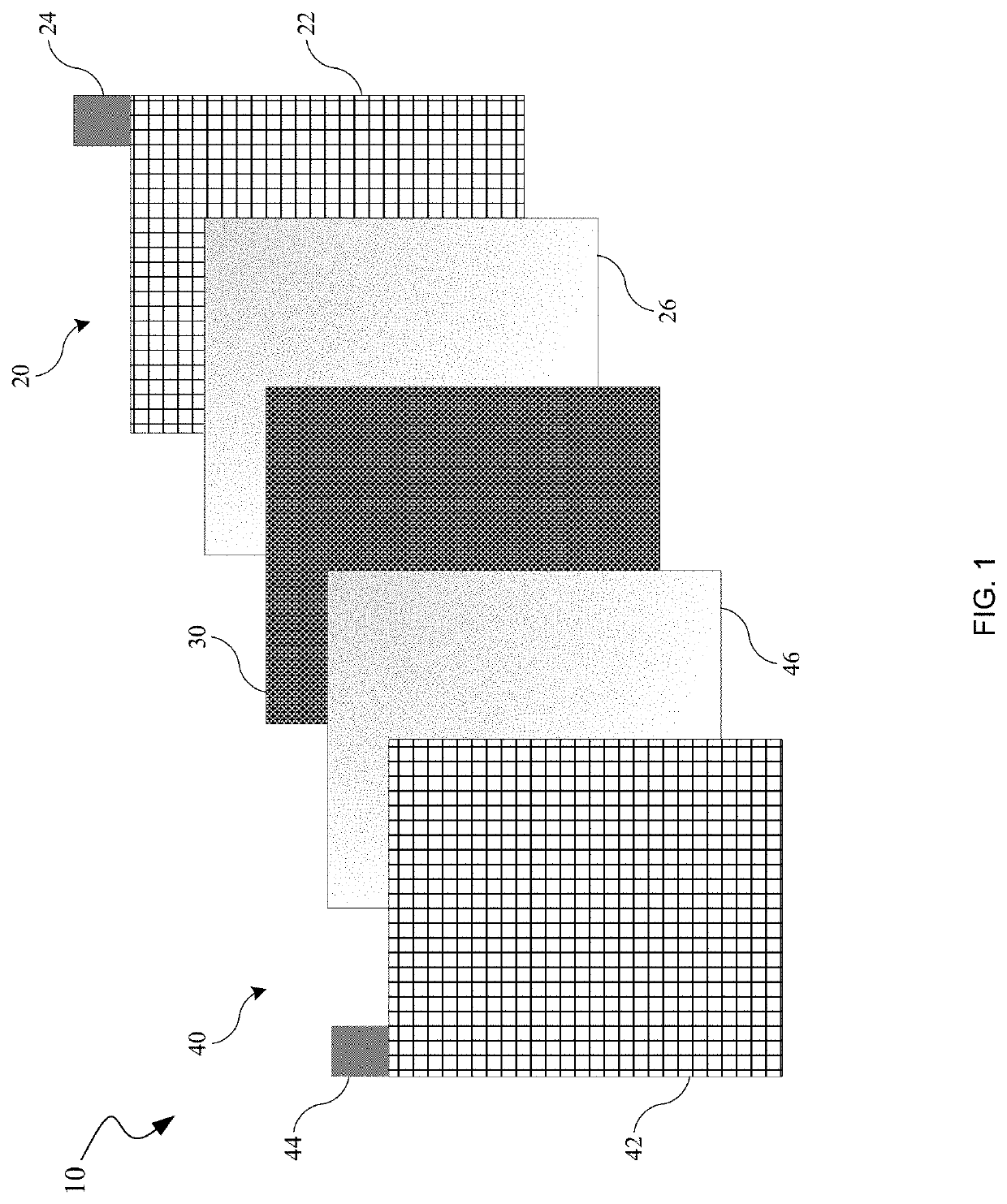Multilayer non-woven mat for lead acid batteries and applications therefor
a lead acid battery and multi-layer technology, applied in the field of non-woven mats, can solve the problems of negative electrode effects of repeated charge and discharge cycles, and achieve the effects of improving function, reducing air permeability, and increasing tensile strength
- Summary
- Abstract
- Description
- Claims
- Application Information
AI Technical Summary
Benefits of technology
Problems solved by technology
Method used
Image
Examples
example 1
[0061]Samples S1-S3 of multilayer non-woven mats are described in Table 1 below as are comparatives C1-C3.
TABLE 1AcidMat CompositionWickBulkPercentagesMat CompositionWt.Air(cm)Wt.XRF (%)(%)(lb / sq)Perm10Sample(lb / sq)M1CSLOICM1SM1 + SM1SM1 + S(cfm / ft2)minComp11.132080015.967.415.80.015.80.180.000.181251.0Comp21.408672518.154.96.520.627.00.090.290.38135.0Comp31.209652618.253.27.421.228.60.090.250.34124.9S11.132575016.862.420.00.020.000.000.22163.1S21.0913721515.061.511.212.323.60.130.130.2685.2S31.0116701415.558.513.912.226.00.120.120.262.75.0
[0062]Comparative single layer non-woven mats Comp1-Comp3 were formed on a pilot wet-laid mat machine using a conventional single headbox configuration. Samples S1-S3 were formed using a pilot wet-laid mat machine having double headbox configuration. Each headbox had a different fiber stock inflow for delivering the two different fiber layers. The double headbox configuration provided one layer of web formed with the fibers from one fiber stock an...
example 2
[0063]Samples S4-S5 are multilayer non-woven mat rolls as described in Table 2 below.
TABLE 2SquareCMDMDAirFootTotalSampleBinderTensileTensilePermWeightThicknessTensileRollC:M2LOI (%)(lbf / 3″)(lbf / 3″)(cfm / ft2)(g / ft2)(mil)(lbf / 3″)S460%:40%43.224.834.9391.22.798.659.8S550%:50%45.321.227.8263.72.738.249.0
[0064]Sample rolls S4-S5 were formed using a production Hydroformer™ wet-laid mat machine having double headbox configuration. The coarse fibers, abbreviated as “C” on Table 2 were glass fibers type ¾″ K249T (Johns Manville) with a nominal fiber diameter of about 13 μm and length of 0.75 inch. The microfibers, abbreviated as “M2” on Table 2, were glass microfiber 210X-253 (Johns Manville) with a nominal fiber diameter of about 3.0 μm. Rolls S4-S5 contained no silica filler. For example, roll S4 contained 43.2% binder and 56.8% fibers and the fiber content ¾″ K249 T: Microfiber 210X-253, or C:M2, was 60%: 40% for the total mat multilayer construction. Roll S5 contained 45.3% binder and 54...
example 3
[0067]Samples S6-S11 of multilayer non-woven mats are described in Table 3 below.
TABLE 3BasisTensileThicknessAir PermTotalSampleweightLOIMD (lbs / 3″)CD (lbs / 3″)(mils)(cfm / ft2)TensileID(lb / Sq)(%)AvgStdevAvgStdevAvgStdevAvgStdev(lbs / 3″)S60.6470.928.391.2217.030.888.810.17255.1335.7245.42S70.6370.025.941.6515.780.679.170.11277.2537.0941.73S80.7071.329.322.0115.961.579.590.16224.8820.8845.28S90.5568.320.470.9712.730.819.760.23303.5024.7733.20S100.6067.522.610.5113.830.4310.520.14305.759.9836.44S110.6263.616.493.8513.160.6110.280.22299.8819.8129.64
[0068]Samples S6-S11 were formed using a pilot wet-laid mat machine having double headbox configuration. All samples S6-S11 had a fiber content including 50% coarse fibers and 50% cellulose fibers. The coarse fibers were glass fibers type ¾″ K249T (Johns Manville) with a nominal fiber diameter of about 13 μm and length of 0.75 inch. The microfibers were UBE cellulose fibers (Canfor Pulp). The feed stocks were configured so that the top layer inc...
PUM
| Property | Measurement | Unit |
|---|---|---|
| diameter | aaaaa | aaaaa |
| diameter | aaaaa | aaaaa |
| thickness | aaaaa | aaaaa |
Abstract
Description
Claims
Application Information
 Login to View More
Login to View More - R&D
- Intellectual Property
- Life Sciences
- Materials
- Tech Scout
- Unparalleled Data Quality
- Higher Quality Content
- 60% Fewer Hallucinations
Browse by: Latest US Patents, China's latest patents, Technical Efficacy Thesaurus, Application Domain, Technology Topic, Popular Technical Reports.
© 2025 PatSnap. All rights reserved.Legal|Privacy policy|Modern Slavery Act Transparency Statement|Sitemap|About US| Contact US: help@patsnap.com



